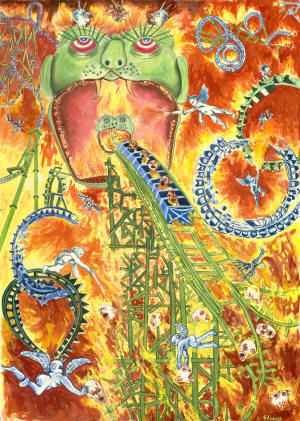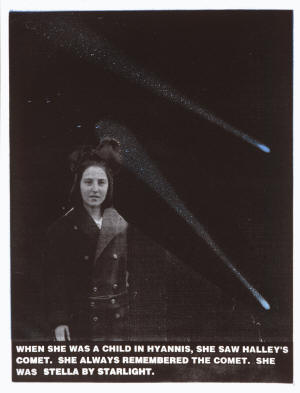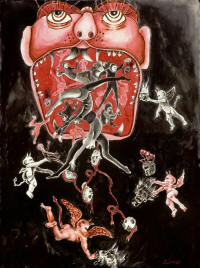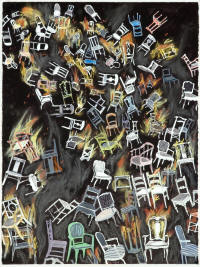University
Communications
Office
Arkansas State University
Jonesboro,
Arkansas
Staff
Markham Howe
Sara McNeil
Gina Bowman
(870) 972-3056
fax (870) 972-3693
More information:
NewsPage
Links to News Releases
& Announcements
KASU
Public Newsroom
KASU Local News
Campus Calendar
Public activities at ASU
About
ASU
Overview, history
and more |
'True Grit' opens at Bradbury
Gallery Aug. 26; five-artist show runs through Oct. 3
August 17, 2010
--
The
Bradbury Gallery
announces the opening of "True Grit" Thursday, Aug. 26, at 5 p.m. The
exhibition will run through Sunday, Oct. 3; it is free and open to the
public. The Bradbury Gallery is located in Fowler Center, 201 Olympic
Drive, Jonesboro. "True Grit" features the work of five American artists
with exceptionally long and productive careers who continue to make
thought-provoking work. Averaging 80 years of age, Judith K. Brodsky,
Peter Campus, Warrington Colescott, Larry Edwards, and Lee Friedlander
have each developed careers spanning more than fifty years that show no
signs of slowing down. As inventive and courageous as ever, their
artistic practices continue to project a sense of curiosity and
engagement with the larger world of ideas. The exhibition is intended
not only as homage, but also as inquiry. What fuels the unwavering
devotion of these artists to work and career? Curators Les Christensen
and John Salvest believe that such an investigation into the
motivational forces driving these artists well past traditional
retirement age has implications beyond the art world—an uncovering of
the physical, cerebral, and spiritual capacities of the human condition.
In a culture fixated on newness and youth, isn’t there still something
to be learned from that which endures? exceptionally long and productive careers who continue to make
thought-provoking work. Averaging 80 years of age, Judith K. Brodsky,
Peter Campus, Warrington Colescott, Larry Edwards, and Lee Friedlander
have each developed careers spanning more than fifty years that show no
signs of slowing down. As inventive and courageous as ever, their
artistic practices continue to project a sense of curiosity and
engagement with the larger world of ideas. The exhibition is intended
not only as homage, but also as inquiry. What fuels the unwavering
devotion of these artists to work and career? Curators Les Christensen
and John Salvest believe that such an investigation into the
motivational forces driving these artists well past traditional
retirement age has implications beyond the art world—an uncovering of
the physical, cerebral, and spiritual capacities of the human condition.
In a culture fixated on newness and youth, isn’t there still something
to be learned from that which endures?
Judith K.
Brodsky,
who was
born in 1933,
has long been
recognized as
an
advocate for both women artists and printmaking. She is Distinguished
Professor Emerita in the Department of Visual Arts at Rutgers, the state
university of New Jersey, where she served as dean and associate provost
as well as chair of the art department at the Rutgers campus at
Newark. She is a past national president of ArtTable, the College Art
Association, and the Women’s Caucus for Art.
is Distinguished
Professor Emerita in the Department of Visual Arts at Rutgers, the state
university of New Jersey, where she served as dean and associate provost
as well as chair of the art department at the Rutgers campus at
Newark. She is a past national president of ArtTable, the College Art
Association, and the Women’s Caucus for Art.
Brodsky is the founding director of the Rutgers Center for Innovative
Print and Paper, renamed the Brodsky Center in her honor in September
2006. Recently she served as chair of the well-received Philagrafika
2010, a citywide international contemporary visual arts festival held in
Philadelphia which focused on the printed image. Brodsky
 has also
organized and curated many exhibitions and written extensively about
women and prints. She was a contributor to the first comprehensive
history of the American women’s movement in art, called The Power of
Feminist Art. While providing consistent and significant service to
numerous professional organizations over the years,
she has
maintained her career as an artist and has never lost the passion to
produce her own work. has also
organized and curated many exhibitions and written extensively about
women and prints. She was a contributor to the first comprehensive
history of the American women’s movement in art, called The Power of
Feminist Art. While providing consistent and significant service to
numerous professional organizations over the years,
she has
maintained her career as an artist and has never lost the passion to
produce her own work.
Peter Campus, born in 1937, is regarded as one of the most important
American video artists and as a seminal figure in the development of
video as an art form.
Yet he made the
conscious decision to step away from video and focused instead on still
photography for a dozen or more years. In this latest phase of his
career, he has returned to work again in video, bringing all that he
learned from these earlier periods to commence yet another visual
experiment incorporating elements of both.
Among the many awards Campus has received are a National Endowment for
the Arts grant, a fellowship from the Center for Advanced Visual Studies
at MIT, and a Guggenheim Fellowship. He was an artist-in-residence at
the Television Laboratory at WNET/Thirteen, New York, and at WGBH-TV,
Boston. Campus has taught at the Rhode Island School of Design and New
York University. His closed-circuit installations, videotapes and
photography have been widely exhibited internationally, in one-person
shows at the Bykert Gallery, New York; Everson Museum of Art, Syracuse;
Leo Castelli Gallery, New York; Kunsthalle Breman, Germany; the Museum
of Modern Art, New York; Whitney Museum of American Art, New York;
Kolnischer Kunstverein, Cologne; Centre Georges Pompidou, Paris;
Institute of Contemporary Art, Philadelphia; and Paula Cooper Gallery,
New York; as well as in numerous group exhibitions at festivals and
institutions including Documenta 6, Kassel, Germany; Venice Biennale;
Walker Art Center, Minneapolis; Hirshhorn Museum and Sculpture Garden,
Washington, D.C.; PS1 Contemporary Arts Center, New York, and Fukui
International Video Festival, Japan.
For
many years, Warrington Colescott, born in 1921, devoted himself to
building a world-renowned printmaking program at the University of
Wisconsin
while still managing to be a highly productive and respected artist
himself.
Now
retired from academia,
and going on ninety
years of age, he seems to be more prolific and his satirical paintings
and prints more relevant than ever. managing to be a highly productive and respected artist
himself.
Now
retired from academia,
and going on ninety
years of age, he seems to be more prolific and his satirical paintings
and prints more relevant than ever.
Colescott has received several prestigious fellowships, including a
Guggenheim, a Fulbright and three National Endowment for the Arts
Artist’s Fellowships. His early graphics were abstractions created in
the medium of serigraphy. By the early 1960s, he turned his focus to
intaglio printmaking and his imagery evolved into social satire and
commentary. He has produced a number of narrative satires, including one
on the history of printmaking. Colescott has exhibited nationally and
internationally and his work is included in the Victoria and Albert
Museum, Metropolitan Museum, Museum of Modern Art, Bibliotheque
Nationale-Paris, and numerous other public collections. He continues to
work daily at his studio in Wisconsin.
Larry Edwards
was born in Mississippi in 1931, a time that was economically depressed
and racially tense, yet, perhaps by necessity, richly creative. His
early observations and sensitivity to this period are evident still in
his ongoing critique of society as seen in his imagery and subject
matter. Even in his most recent body of work, from
 the summer of 2010,
his colorful yet dark-humored paintings vigorously assess humanity’s
baser instincts. In his artist’s statement he says, “I see a dangerous
struggle everywhere. With the so-called ‘lower animals’ this struggle,
in nature, is for simple survival. For humanity there is added
complexity. Freud once said that ‘we ought not to exalt ourselves so
highly as to completely neglect what was originally animal in our
nature.’ The consequences of our failure to heed this advice are of
primary interest to me. I do not see my work as a condemnation of life.
I simply observe the struggle on all levels and report it as I see it.” the summer of 2010,
his colorful yet dark-humored paintings vigorously assess humanity’s
baser instincts. In his artist’s statement he says, “I see a dangerous
struggle everywhere. With the so-called ‘lower animals’ this struggle,
in nature, is for simple survival. For humanity there is added
complexity. Freud once said that ‘we ought not to exalt ourselves so
highly as to completely neglect what was originally animal in our
nature.’ The consequences of our failure to heed this advice are of
primary interest to me. I do not see my work as a condemnation of life.
I simply observe the struggle on all levels and report it as I see it.”
Edwards has lived and taught art at schools and universities in five
states. For the past 60 years, he has exhibited in numerous solo and
group exhibitions from Maine, New Jersey, and New York to Washington
D.C., Ohio, Kansas, Indiana, and Pennsylvania, as well as virtually
every southern city and state on the eastern seaboard. He has received
several grants, including a fellowship from the Penny McCall Foundation,
Art M atters Inc. in New York, and a Tennessee Arts Commission
Fellowship. Since his retirement, he spends nearly every day working in
his studio, making wonderfully strange and sagacious work with the
energy and enthusiasm of a teenager. atters Inc. in New York, and a Tennessee Arts Commission
Fellowship. Since his retirement, he spends nearly every day working in
his studio, making wonderfully strange and sagacious work with the
energy and enthusiasm of a teenager.
Lee
Friedlander, a photographer, was born in 1934. Like Edwards, he too was
drawn to capturing imagery of American society. These works include
portraits of jazz musicians and street photography.
Producing hundreds
and hundreds of striking images throughout his long career, he is
recognized for his dense landscapes, self-portraits, humorous and
poignant images among the chaos of city life, and countless other
subjects.
Friedlander’s most current work, which can be seen in "True Grit," shows
an artist still working at the height of his powers late into
his
career.
Friedlander’s
first solo exhibition was mounted at the
International Museum of Photography at
George Eastman House in 1963. He has since had a vast number of solo
exhibitions and
was included in the
highly influential 1967 New Documents exhibition, curated by John
Szarkowski at the Museum of Modern Art.
In 1990,
he received a prestigious MacArthur Fellowship.
Among the many
monographs on Friedlander’s work are Sticks and Stones, Lee
Friedlander Photographs, Letters from the People, Apples
and Olives, Cherry Blossom Time in Japan, Family, and
People at Work. Lee Friedlander was the subject of a major
traveling retrospective and catalog organized by the Museum of Modern
Art in 2005.
"True Grit" was curated by Les Christensen, director of the Bradbury
Gallery, and John Salvest, professor of Art at Arkansas State
University, and was previously on view at the Salina Art Center in
Salina, Kansas, from January 29 through April 18, 2010.
Bradbury Gallery hours are noon to 5 p.m., Tuesday through Saturday, and
2-5 p.m. on Sunday. The exhibition is free and open to the public. For
additional information, contact
Les Christensen, director of the Bradbury Gallery, at
lchristensen@astate.edu, or
call the Bradbury Gallery at (870) 972-2567.
Images, from top:
Larry Edwards
"Hellmouth No. 2, Imps, Sinners and Rollercoasters," 2006
Gouache, pastel, watercolor, and ink on paper
40 x 30 inches
Courtesy of the artist.
Judith K. Brodsky
"Why do we sleep?", 2010
from "The 20 Most Important Scientific Questions of the 21st Century"
series
Photo etching
30 x 44 inches
Courtesy of the artist.
Judith K. Brodsky
"Stella by Starlight, 1999-2003"
From "The Memoir of an Assimilated Family" series
Photo etching
25 x 20 inches
Courtesy of the artist.
Warrington Colescott
"Hit On Huey, 2005"
color etching
Courtesy of ASU Permanent Collection of Art.
Larry Edwards
"Hellmouth No. 1, Imps and Sinners," 2006
Gouache, pastel, and ink on paper
30 x 22 inches
Courtesy of the artist.
Larry Edwards
"Chairs Falling and Flaming," 2008
Gouache, ink, watercolor, pastel, and pencil on paper
30 x 22 inches
Courtesy of the artist.
# # #
|
